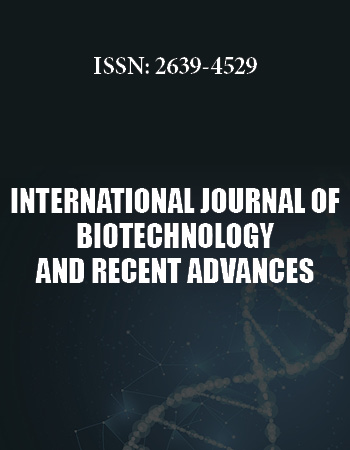Research Article
Growth and Immune Response of Broilers in Relation to Varying Dietary levels of Methionine and Threonine
1Institute of Animal and Dairy Sciences, University of Agriculture, Faisalabad, Pakistan
2Evonik (SEA) Pte. Ltd, 609927, Singapore
*Corresponding author: Muhammad Umar Yaqoob, Institute of Animal and Dairy Science, University of Agriculture, Faisalabad, Pakistan, E-mail: yaqoobmumar@gmail.com
Received: April 30, 2018 Accepted: May 25, 2018 Published: May 30, 2018
Citation: Yaqoob MU, Ali M. Growth and Immune Response of Broilers in Relation to Varying Dietary levels of Methionine and Threonine. Int J Biotechnol Recent Adv. 2018; 1(1): 6-11. doi: 10.18689/ijbr-1000102
Copyright: © 2018 The Author(s). This work is licensed under a Creative Commons Attribution 4.0 International License, which permits unrestricted use, distribution, and reproduction in any medium, provided the original work is properly cited.
Summary
Amino acids are structural and functsystem.ional units of protein, nutritionally categorized into two groups; essential and non-essential amino acids. Amino acids play important physiological functions inside the body. Extensive research has been done on the use of synthetic amino acids in poultry feed. The uses of synthetic amino acids in diets make it easy to study dose dependent response in poultry birds. Methionine is considered as a first limiting amino acid in corn soya poultry diets. It is a sulphur containing amino acid (SAA) and plays important role for optimum growth performance of broilers. It is involved in muscle accretion, feather synthesis and important biochemical processes (as methylgroup donator). Methionine has been extensively supplemented in broilers diet to enhance the production performance and to decrease the cost of production in commercial broiler farming systems. Nutrient recommendations are available in order to achieve high broiler performance, but the levels of SAA can varies depending upon the production goal such as the optimization for breast meat yield or feed efficiency etc. Threonine is third limiting amino acid in poultry diet. A lot of research work has been done to find optimal level of threonine to get high broiler’s performance. Threonine has an impotent role in the gut health as an essential component of mucin. Threonine is the part of immuno-globulins and also works as proteinogenic amino acid. The health status of birds has a direct link with their immune system and broilers with strong immune system grow better. Research has showed that birds shows better performance at higher dietary methionine and threonine levels with better immune system.
Keywords: Methionine+Cystine; Threonine; Growth performance; Immune response; Broilers.
Introduction
Proper concentration and proportion of different amino acids should be present in the diet according to the requirements of broilers. Under feeding of amino acids decrease the production performance and over feeding will lead to increase the cost of production and nitrogen excretion [21]. As animal protein sources are not being used due to various negative effects associated to them. Nowadays, protein sources of plant origin are extensively used in commercial poultry ration formulations. Plant sources are generally deficient in sulphur containing amino acids (SAA), therefore, the supplementation of methionine (Met) is done to fulfil its requirement [35]. Threonine (Thr) is the most limiting amino acid after sulphur containing amino acids [40]. It involves in important metabolic processes i.e. protein synthesis and formation of uric acid [32]. Threonine also plays important roles in physiological functions as an essential component of intestinal mucin [6]. Threonine is about 28-40% of total amino acids in mucin [26]. Mucin not only involves in digestion and absorption of nutrients but also protect gut from digestive enzymes, acidic chyme and pathogens [14]. Due to passage of food trough GIT mucin is continuously slough off and its most part is not digested so Thr cannot be recovered [10], so it must be supplemented in the diet of poultry.
The dietary protein level can be reduced by the supplementation of synthetic amino acids [18]. The use of amino acids reduces the loss of nitrogen during protein metabolism which ultimately results in low ammonia excretion in environment and improves growth performance of the birds [18]. Information about minimum requirements of amino acids is available [28]. These requirements were established under ideal conditions whereas under commercial broiler farming conditions these established values are lower than requirements [24].
Supplementation of amino acids in poultry diets improve the growth performance and strengthen the immune system [20,31]. Immune proteins isolated from mammalian plasma have higher concentration of Met and Thr than other amino acids [36]. The level of methionine +cystine (M+C) and Thr modulated the expression of immune genes in broilers [4]. Methionine enhances the production of antibodies in broilers [37]. Threonine is required for gut health [1], and stimulates the production of antibodies in lymphocytes [8]. It is an essential component of intestinal mucin [8,23] which protects internal linings of GIT. Threonine is required for synthesis of mucin, because Thr has hydroxyl group that is used to develop ester linkage with carboxyl groups [27]. So the use of Thr for synthesis of mucin may be compromised if diet is deficient in Thr which may affect the growth performance of broilers [26]. Dressing percentage can be significantly improved by extra supplementation of synthetic amino acids in diet than NRC recommendations [30]. Higher level of Met in diet decreasesthe fat % in meat [15,35]. Carcass and breast meat yield can be increased by using higher concentration of Thr in broiler diet without affecting the abdominal fat production [25,16].
This review explores existing information about effect of dietary Met and Thr levels on production performance of broilers and to deliver vision on its future commercial application in the poultry industry.
Effect of methionine supplementation on growth performance
Effect of different levels (starter phase 0.31-1.10%; finisher phase 0.29-0.87%) of Met on growth performance of broilers is presented in Table 1. Many studies have been conducted to evaluate the effect of different dietary Met levels on growth performance of broilers. Results of these studies showed that the increasing dietary Met level increase the body weight gain. [34] observed better FCR at Met level of 0.51% compared with 0.31% Met in diet. [11] also found better FCR at 0.54% Met in starter diet compared to 0.42% Met level.
Dietary Met level also affects the feed efficiency. [13] reported that the FCR decreased by increasing the Met level from 0.50 to 0.56%. [2] conducted two experiments on broilers during starter phase and got lowest FCR at dietary Met level of 1.10%. Similarly, research has been conducted on broilers during finisher phase to find optimal level of Met for production performance. Best FCR was found at 0.41% dietary Met [11] while the results of another experiment [35] showed better FCR at 0.51% Met in diet. Great variation in Met requirement to get optimum performance was observed in different studies [34,2]. Difference in Met requirements might be due to different strains of broilers and environmental variations.
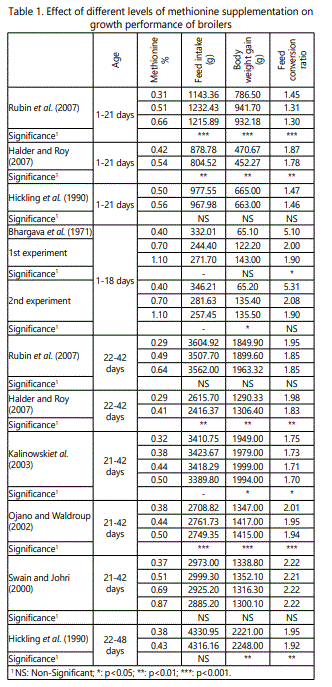
Effect of threonine supplementation on growth performance
Threonine is third limiting amino acid in poultry diet [18,19]. Extensive research work has been done to find optimal level of Thr for growth performance of broilers for many years [30,9,12,32]; [1] Growth performance of broilers against different dietary levels (0.64 to 1.55%) of Thr during different phases is presented in Table 2. [1] conducted experiment in three phases and used varying Thr levels, during first phase (1-12 days) best FCR with highest weight gain was observed at 0.98% Thr. During second phase (13-25 days) best FCR and weight gain was at Thr level of 0.95%, while in third phase (26-45 days) highest weight gain and better FCR was obtained at dietary Thr level of 0.78 and 0.85%, respectively. [12] got best FCR with highest weight gain at 0.87% Thr, during starter phase of broilers. [32] used Thr in diet and observed lowest FCR at 1.55% Thr (1 – 21 days). [9] conducted experiment in two phase, during first phase (14-28 days) highest weight gain and lowest FCR was obtained at Thr level of 0.73 and 0.77%, respectively while four levels of Thr were used (0.69, 0.73, 0.77 and 0.81%). During second phase of experiment (28-42 days), Thr levels were used form 0.60-0.72% with difference of 0.4 between successive groups and result showed highest weight gain with lowest FCR at 0.72% Thr. The results of experiment conducted by [30] showed better Thr level for FCR and weight gain was 0.87% at age of 21-42 days of broiler. In above mentioned experiments feed intake during starter phase was increase by increasing dietary Thr levels up to certain level and then start to decrease. During finisher phase intake was positively correlated with graded levels of Thr used in diets.
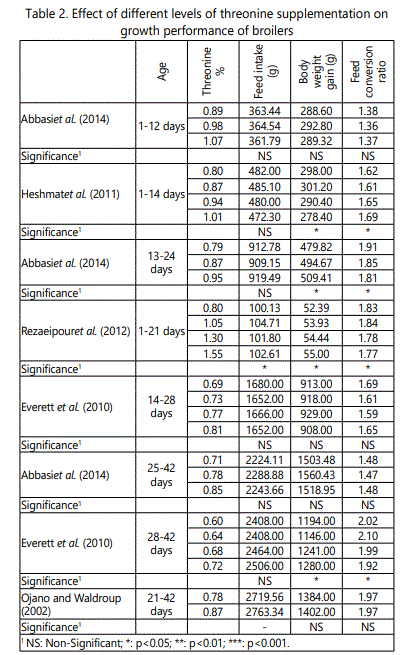
Effect of methionine supplementation on carcass characteristics
Different Met supplementation levels affect the carcass characteristics in broilers. [11] found higher carcass% in broilers fed diet containing Met level of 0.24 and 0.29% during starter and finisher rations, respectively. [30,13] reported positive relationship between dressing% and level of Met used. [33] conducted research on male and female broilers separately and the results showed higher carcass% and breast yield at dietary Met levels of 0.69 and 0.93% for male and female broilers, respectively.The increase in the Met level in diet increased the thigh% [11] but abdominal fat% was decreased [11,29,17,32]. Relative weight of liver also improved by feeding higher dietary Met level to broilers [3].
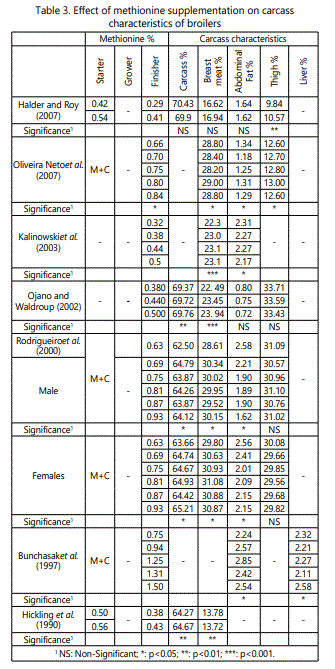
Effect of threonine supplementation on carcass characteristics
[1] used three dietary Thr levels in starter (0.89, 0.98 and 1.07%), grower (0.79, 0.87 and 0.95%) and finisher (0.71, 0.78 and 0.85%) phase and observed highercarcass and breast meat% at dietary Thr level of 0.98, 0.87 and 0.78% during starter, grower and finisher phase, respectively. The highest thigh% was found at Thr level of 1.07, 0.95 and 0.85%, respectively. (32) reported increase in breast meat (22.26 to 23.67%) and decrease in abdominal fat (1.70 to 1.62%) by increasing dietary Thr level from 0.08 to 0.16% during starter phase in broilers. [9] also observed higher carcass and breast meat yield by feeding diet containing Thr 0.77 and 0.68% during starter and grower phase, respectively. [5] found higher carcass and breast meat yield and lower abdominal fat at Thr levels of 0.65 and 0.86%, respectively. [7] conducted trials on male and female broilers separately and found highest carcass and lowest abdominal fat at Thr level of 0.63 and 0.52% for male and female broilers, respectively. [22] used different levels of Thr in broilers diet and observed higher breast meat yield at 0.67% and lowest abdominal fat at 0.85% Thr level in diet during finisher phase.
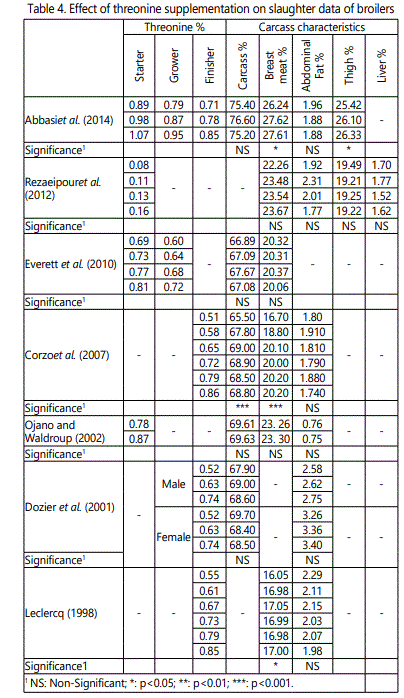
Effect of methionine and threonine supplementation on immune response
Growth performance of living organisms directly related to their health status. A strong immune system means that individual is less prone to attack of diseases. Immune response is reviewed by investigating antibody titer levels mainly against infectious bursal disease virus (IBDV) and Newcastle disease virus (NDV). Data on the effect of Met and Thr supplementation on immune response in broilers is presented in Table 5. [24] found higher antibody titer levels against NDV at Met level of 0.75 and 0.49% during starter and finisher phase, respectively. But the higher titer level against IBDV was found at Met levels of 1.27 and 0.88% during starter and finisher phase, respectively. [2] conducted two experiments to find Met level for maximum antibody titer levels during starter phase. In both experiments, highest titer level against NDV was found at 0.40% Met in diet. In another experiments [35] maximum antibody titer level against NDV and IBDV was found at Met level of 0.87 and 0.37%, respectively.
[1] used different dietary Thr levels in starter, grower and finisher diets of broilers and found highest antibody titter levels at dietary Thr level of 0.98, 0.87 and 0.78% in starter, grower and finisher phase, respectively. [32] found highest antibody titer level against NDV at dietary Thr level of 0.11 and 0.16% after 1st and 2nd vaccine, respectively during starter phase; but second antibody titer level was comparatively higher than that of first. [24] used different dietary Thr levels in starter and finisher diets and found higher antibody titer levels by feeding 1.62 and 1.51% Thr during two phases mentioned above, except 1st antibody titer level against NDV which was highest at 0.88 and 0.76% Thr during starter and finisher phase, respectively. [38,39]
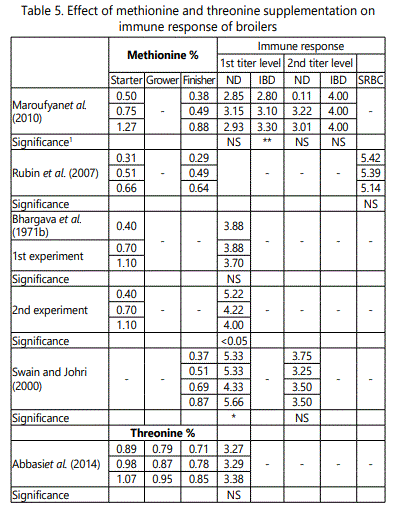
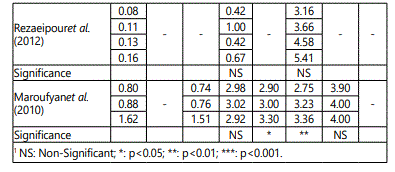
Conclusion
Keeping in view the present review it may be concluded that;
Broilers showed better performance at higher dietary level of Methionine and threonine, broiler’s diet should be supplemented with these amino acids to enhance growth performance and to strengthen their immune system
References
- Abbasi MA, Mahdavi AH, Samie AH, Jahanian R. Effects of different levels of dietary crude protein and threonine on performance, humoral immune responses and intestinal morphology of broiler chicks. Rev. Bras. Cienc. Avic. 2014; 16: 35-4 doi: 10.1590/S1516-635X2014000100005
- Bhargava KK, Hanson RP, Sunde ML. Effects of methionine and Valine on growth and antibody production in chicks infected with live or killed Newcastle disease virus. Poult. Sci. 1971; 50: 614-619. doi: 10.3382/ps.0500614
- Bunchasak C, Santoso U, Tanakaz K, Ohtani S, Cristino M. The effect of supplementing methionine plus cystine to a low-protein diet on the growth performance and fat accumulation of growing broiler chicks.Asian Austral. J. Anim.Sci. 1997; 10: 185-191. doi: 10.5713/ajas.1997.185
- Bhanja SK, Sudhagar M, Goel A, Pandey N, Mehra M, et al. Differential expression of growth and immunity related genes influenced by in ovo supplementation of amino acids in broiler chickens. Czech. J. Anim. Sci. 2014; 59: 399-408.
- CorzoA, Kidd MT, Dozier WA, Pharr GT, Koutsos EA. Dietary threonine needs for growth and immunity of broilers raised under different litter conditions. J. Appl. Poult. Res. 2007; 16: 574-582. doi: 10.3382/japr.2007-00046
- Carlstedt I, Herrmann A, Karlson H, Sheehan J, Fransson LA. Characterization of different glycosylated domains from the insoluble mucin complex of rat small intestine. J Biol Chem. 1993; 268: 18771-18781.
- Dozier WA, Moran ET, Kidd MT. Comparisons of male and female broiler responses to dietary threonine from 42 to 56 days of age. J. Appl. Poult. Res. 2001; 10: 53-59. doi: 10.1093/japr/10.1.53
- Duval D, Demangel C, Munierjolain K, Miossec S, Geahel I. Factors controlling cell proliferation and antibody production in mouse hybridoma cells. Influence of the amino acid supply. Biotechnol. Bioeng. 1991; 38: 561-57 doi: 10.1002/bit.260380602
- Everett DL, Corzo A, Dozier WA, Tillman PB, Kidd MT, et al. Lysine and threonine responses in Ross TP16 male broilers. J. Appl. Poult. Res. 2010; 19: 321-326. doi: 10.3382/japr.2010-00152
- Fuller MF, Amino acid requirements for maintenance of body protein accretion and reproduction in pigs. In: Amino Acids in Farm Animal Nutrition. CAB International, Wallingford, UK. 1994: 155-184.
- Halder G, Roy B. Effect of herbal or synthetic methionine on performance, cost benefit ratio, meat and feather quality of broiler chicken. Int. J. Agri. Res. 2007; 2: 987-996. doi: 10.3923/ijar.2007.987.996
- Heshmat M S, Hassan N, Moghaddam H, Kermanshahi AH, Mosavi, et al. The effect of threonine on mucin 2 gene expression, intestinal histology and performance of broiler chicken. Ital. J. Anim. Sci. 2011; 10:14. doi: 10.4081/ijas.2011.e14
- Hickling D, W Guenter, ME Jackson. The effects of dietary methionine and lysine on broiler chicken performance and breast meat yield. Can. J. Anim. Sci. 1990; 70: 673-678. doi: 10.4141/cjas90-079
- Horn NL, Donkin SS, Applegate TJ, Adeola O. Intestinal mucin dynamics: Response of broiler chicks and White Pekin ducklings to dietary threonine. Poult. Sci. 2009; 88: 1906-1914. doi: 10.3382/ps.2009-00009
- Jeroch H, Pack M. Effect of dietary sulphur amino acids and crude protein on the performance of finishing broilers. Arch. Anim. Nutr. 1995; 48: 109-118. doi: 10.1080/17450399509381833
- Jahanian R. Threonine needs of growing broiler chickens for performance and optimum immunological functions in response to dietary crude protein concentration. 2nd International Veterinary Poultry Congress. Tehran. Iran. 2010; 200.
- Kalinowski A, Moran ET, Wyatt CL. Methionine and cystine requirements of slow-and fast-feathering broiler males from three to six weeks of age. Poult. Sci. 2003; 82: 1428-1437. doi: 10.1093/ps/82.9.1428
- Kidd MT, Kerr BJ. L-threonine for poultry: A review. J. Appl. Poult. Res. 1996; 5: 358-367. doi: 10.1093/japr/5.4.358. doi: 10.1093/japr/5.4.358
- Kidd MT. Nutritional consideration concerning threonine in broilers. W. Poult. Sci. J. 2000; 56:139-151. doi: 10.1079/WPS20000011
- Kidd MT, Gerard PD, Heger J, Kerr BJ, Rowe D, et al. Threonine and crude protein responses in broiler chicks. Anim. Feed Sci. Tech. 2001; 94: 57-64. doi: 10.1016/S0377-8401(01)00301-7
- Kidd MT, McDaniel CD, Branton SL, Miller ER, Boren, et al. Increasing amino acid density improves live performance and carcass yields of commercial broilers. J. Appl. Poult. Res. 2004; 13: 593-604. doi: 10.1093/japr/13.4.593
- Leclercq BE. Lysine: Specific effects of lysine on broiler production: comparison with threonine and valine. Poult. Sci. 1998; 77: 118-123. doi: 10.1093/ps/77.1.118
- Lien KA, Sauer WC, Fenton M. Mucin output in ilealdigesta of pigs fed a protein-free diet. Z. Ernahrungswiss. 1997; 36: 182-190. doi: 10.1007/BF01611398
- Maroufyan E, Kasim A, Hashemi SR, ChwenLoh T, Bejo MH. The effect of methionine and threonine supplementations on immune responses of broiler chickens challenged with infectious bursal disease. Am. J. Appl. Sci. 2010; 7: 44-50. doi: 10.3844/ajassp.2010.44.50
- Mejia L, Tillman PB, Zumwalt CD, Corzo A. Assessment of the threonineto-lysine ratio of male broilers from 35 to 49 days of age. J. Appl. Poult. Res. 2012; 21: 235-242. doi: 10.3382/japr.2011-00344
- Nichols NL, Bertolo RF. Luminal threonine concentration acutely affects intestinal mucosal protein and mucin synthesis in piglets. J. Nutr. 2008; 138: 1298-1303. doi: 10.1093/jn/138.7.1298
- Montagne L, Piel C, Lalles JP. Effect of diet on mucin kinetics and composition: Nutrition and health implications. Nutr. Rev. 2004; 62: 105-114. doi: 10.1111/j.1753-4887.2004.tb00031.x
- National Research Council. Nutrient Requirements of Poultry. 9th Rev. Edition. Natl. Acad. Pres, Washington, 1994.
- Oliveira N, de Rodrigues A, de Oliveira RM, Donzele JL, de Toledo Barreto SL, et al. Levels of total methionine + cystine for 22-to-42-day-old broilers kept under thermoneutral environment. Zootec. 2007; 36:1359-1364. doi: 10.1590/S1516-35982007000600019
- Ojano-Dirain CP, Waldroup PW. Evaluation of lysine, methionine and threonine needs of broilers three to six weeks of age under temperature stress. Int. J. Poult. Sci. 2002; 1: 16-21.
- Quentin M, Bouvarel I, Picard M. Effects of starter diet, light intensity and essential amino acids level on growth and carcass composition of broilers. J. Appl. Poult. Res. 2005; 14:69-76. 10.1093/japr/14.1.69. doi: 10.1093/japr/14.1.69
- Rezaeipour V, Fononi H, Irani M. Effects of dietary L-threonine and Saccharomyces cerevisiae on performance, intestinal morphology and immune response of broiler chickens S. Afr. J. Anim. Sci. 2012; 42: 266-273. doi: 10.4314/sajas.v42i3.8
- Rodrigueiro R, Barbosa J, Albino LFT, Rostagno HS, Gomes PC, Pozza PC, Neme R. Methionine+ cystine requirement for broilers at the growing and finishing phases. R. Bras. Zootec. 2000; 29: 507-517. doi: 10.1590/S1516-35982000000200026
- Rubin LL, Canal CW, Ribeiro ALM, Kessler A, Silva I, et al. Effects of methionine and arginine dietary levels on the immunity of broiler chickens submitted to immunological stimuli. Rev. Bras. Cienc. Avic. 2007; 9: 241-247. doi: 10.1590/S1516-635X2007000400006
- Swain BK, Johri TS. Effect of supplemental methionine, choline and their combinations on the performance and immune response of broilers. Brit. Poult. Sci. 2000; 4: 83-88. doi: 10.1080/00071660086457
- Smith EL, Greene RD. Further studies on the amino acid composition of immune protein. J. Biol.Chem. 1977; 171: 355-362.
- Tsiagbe VK, Cook ME, Harper AE, Sunde ML. Enhanced immune responses in broiler chicks fed methionine-supplemented diets. Poult. Sci. 1987; 66: 1147-1154. doi: 10.3382/ps.0661147
- Van Klinken BJ, Dekker J, Buller HA, Einerhand AW. Mucin gene structure and expression: protection vs. adhesion. Am. J. Physiol. Gastr. 1995; 269: 613-627.
- Virtanen E, Rosi L. Effects of betaine on methionine requirement of broilers under various environmental conditions. Proceeding of the Australian Poultry Science Symposium, University of Sydney, Australia, 1995; 88-92.
- Waldroup PW, Jiang Q, Fritts CA. Effects of glycine and threonine supplementation on performance of broiler chicks fed diets low in crud protein. Int. J. Poult. Sci. 2005; 4: 250-257. doi: 10.3923/ijps.2005.250.257

